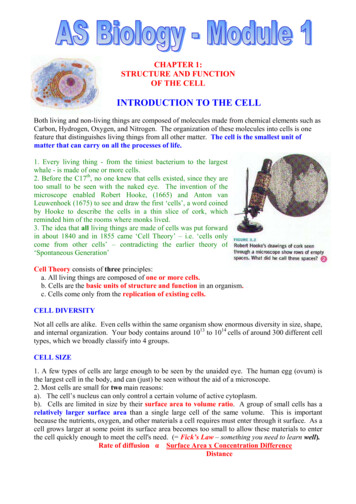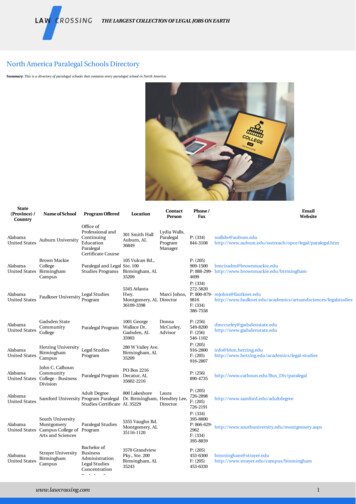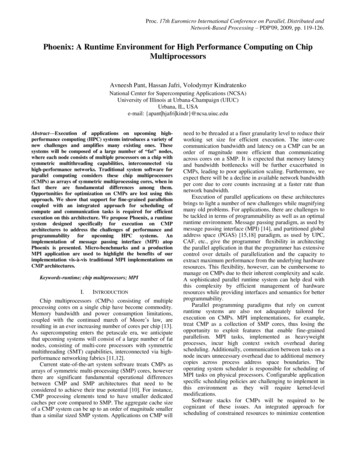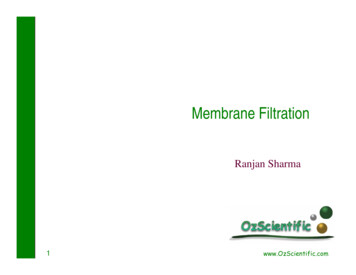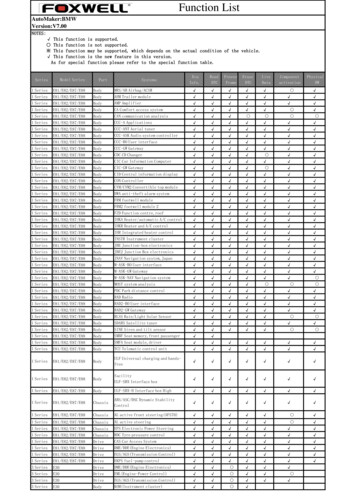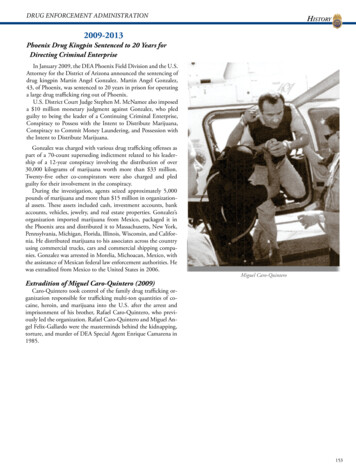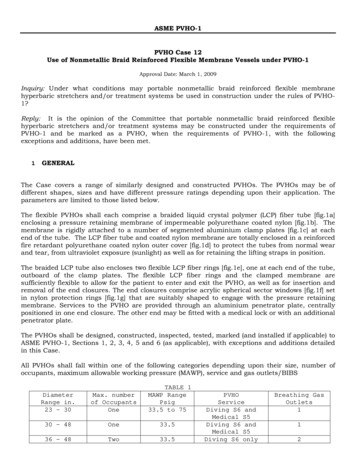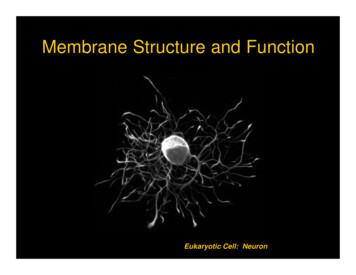
Transcription
Membrane Structure and FunctionEukaryotic Cell: Neuron
Membrane Structure and FunctionAll cells have a plasma or cell membrane, which contains thecell. Scanning electron micrograph (SEM) of adipocytes (Ad)
Membrane Structure and FunctionProkaryotic Cells: Bacteria
The Formation of Cell Membranesis Crucial to Life
Functions of the Cell Membrane Contains the cell Regulates the trafficof molecules andsubstances in and outof the cell (semipermeablemembrane)
Cell Membrane StructurePancreatic Secretory Cell: TEM of Basal and ApicalParts
Major Components of the CellMembrane The major constituents of thecell membrane are proteinsand lipids Membrane proteins and lipidsare arranged in a particularfashion, both contributing tocontaining the cell and toselectively allowing or blockingthe traffic of certain substancesthrough the cell Such arrangement ofmolecules provides fluidity tothe cell membrane
Major Components of the CellMembrane: Lipids Phospholipids areamphipathic molecules(with hydrophobic tailsand a hydrophilic head) One of the phospholipidtails exist mostly in atrans configuration,providing more fluidity tothe membrane Cholesterol is a rigidmolecule that makesmembranes less fluidCholesterol
Major Components of the CellMembrane: LipidsOne of the phospholipid tails exist mostly in atrans configuration, providing more fluidity to themembraneCholesterol is a rigid molecule that makesmembranes less fluid
How Are Phospholipids Organizedin the Cell Membrane? Phospholipids constitutetwo mirror-image orientedlayers — the lipid bilayer The hydrophilic heads areexposed to the highcontent water regions,while the hydrophobictails constitute a barrierimpenetrable to almost allsubstances
hydrophobic tails: repel water:phospholipids: lipid bilayer50%50%sensenomakesmakessense1. makes sense2. makes no sense
Major Components of the CellMembrane: Membrane Proteins Membrane proteins areembedded in the fluid matrix ofthe lipid bilayer More than 50 types of proteinshave been found in the plasmamembrane. Membraneproteins determine most of themembrane specific functions Transport proteins, enzymesand receptor proteins(membrane proteins thatinteract with other cells ormolecules) include the vastmajority of membrane proteins
Major Components of the CellMembrane: Organization
Major Components of the CellMembrane: Organization
Functions of the Cell Membrane Contains the cell Regulates the trafficof molecules andsubstances in and outof the cell (semipermeablemembrane)
Traffic of Substances Across thePlasma Membrane Selective Bidirectional Depending Upon Differences ofConcentration Inside and Outside of theCell
Traffic of Substances Across thePlasma Membrane Selective: only a few molecules can go throughthe lipid bilayer. Transport proteins mostlydetermine what substances cross the cellmembrane, as they carry out the majority ofmembrane transport
Traffic of Substances Across thePlasma Membrane Bidirectional: only afew molecules can gothrough the lipidbilayer. Transportproteins determinewhat substancescross the cellmembrane.Transport can occurin/out or out/in
Traffic of Substances Across thePlasma Membrane Depending UponDifferences ofConcentrationInside and Outsideof the Cell: Osmosisand diffusion are thetwo main processesby which moleculesmove across the cellmembrane
control the traffic of moleculesthrough the cell membraneMembrane proteinsLipidsMembrane proteinsand ns33% 33% 33%
Traffic of Substances Across thePlasma Membrane: Osmosis Osmosis is the movementof water and some smallmolecules through asemi-permeablemembrane from areas oflow concentration ofsolutes to areas of highconcentration of solutes Why does water move inthat particular direction?
Traffic of Substances Across thePlasma Membrane: Osmotic Shock
Traffic of Substances Across thePlasma Membrane: Osmosis Draw a situationwhere theextracellularenvironment is suchthat water flows out ofthe cell Is the extracellularenvironment hypo-,hyper-, or isotonic?
In this situation, will water flow outof the cell?50%50%[NaCl] 1.1 mg/ml1. Yes2. NoNoYes[NaCl] 0.03 mg/ml
Traffic of Substances Across thePlasma Membrane: Diffusion Diffusion is the movement of substances from anarea of high concentration of solutes to an areaof low solute concentration (down to aconcentration gradient)
Traffic of Substances Across thePlasma Membrane: Diffusion Draw a situation where amolecule of NaCl willenter the cell. Assumethat a transport protein isneeded Is the extracellularenvironment hypo-,hyper-, or isotonic? Direction of water?
In this situation, will a molecule ofNaCl enter the cell?50%50%[NaCl] 1.1 mg/ml1. Yes2. NoNoYes[NaCl] 1.9 mg/ml
Traffic of Substances Across thePlasma Membrane: FacilitatedDiffusion Facilitated diffusion is aprotein-mediated passive(no energy required)diffusion of moleculesacross the cell membrane Transport proteins carryout facilitated diffusion;facilitated diffusion is veryselective, as eachtransport proteintransports just one type ofmolecule
Traffic of Substances Across thePlasma Membrane: Active Transport Active transport is a proteinmediated transport ofmolecules across the cellmembrane against aconcentration gradient (low tohigh solute concentrationareas). It requires a boost ofenergy (ATP) to occur. Asfacilitated diffusion, is veryselective Glucose is actively transportedthrough the plasma membraneof intestinal cells
Bulk Transport of Substances Acrossthe Plasma Membrane: Exocytosis andEndocytosisPancreatic Secretory Cell: TEM
Types of Endocytosis: PhagocytosisIn phagocytosis (“cell eating”), a cellengulfs a particle or another cellthrough the emission of pseudopodia,and packs it into a vacuole. Thecontents of the vacuole is digested afterthe vacuole fuses with a lysosomePhagocytosis of erythrocytes (Er) byblood macrophages (Ma).
Types of Endocytosis: Pinocytosis In pinocytosis (“cell drinking”), the cell takes indroplets of extracellular fluid into small vesicles.Many molecules enter the cell dissolved in thedroplets in a non-specific manner
Types of Endocytosis: ReceptorMediated Endocytosis Receptor-mediated endocytosisrequires of specific receptor proteinslocated in the cell membrane. Cellreceptors interact with the molecule tobe transported into the cell through aligand — a molecule that bindsspecifically to the receptorReceptor-mediated endocytosis ishighly specific. Human cells usereceptor-mediated endocytosis to takein cholesterol. Some viruses (i.e. HIVvirus) enters the cell through receptormediated endocytosisMutations in receptor proteins involvedin receptor-mediated endocytosisusually block the entrance ofsubstances meant to be transportedby this process (i.e. natural HIVimmunity, familialhypercholesterolemia)
The arrows point to a process of:1. receptor-mediatedendocytosis2. exocytosis3. d.33% 33% 33%
The arrows point to a process of:1. receptor-mediatedendocytosis2. exocytosis3. d.33% 33% 33%
Cell receptors interact with the molecule to be transported into the cell through a ligand — a molecule that binds specifically to the receptor Receptor-mediated endocytosis is highly specific. Human cells use receptor-mediated endocytosis to take in cholesterol. Some viruses (i.e. HIV

